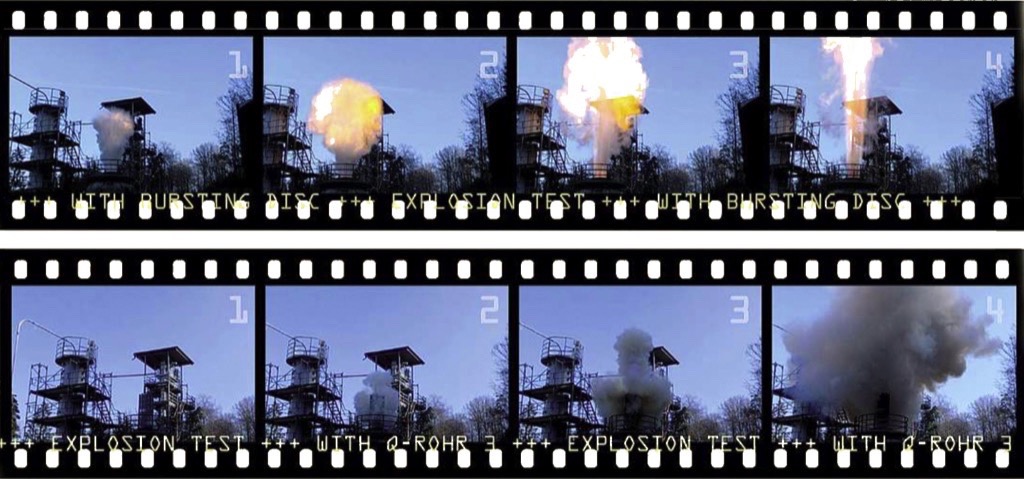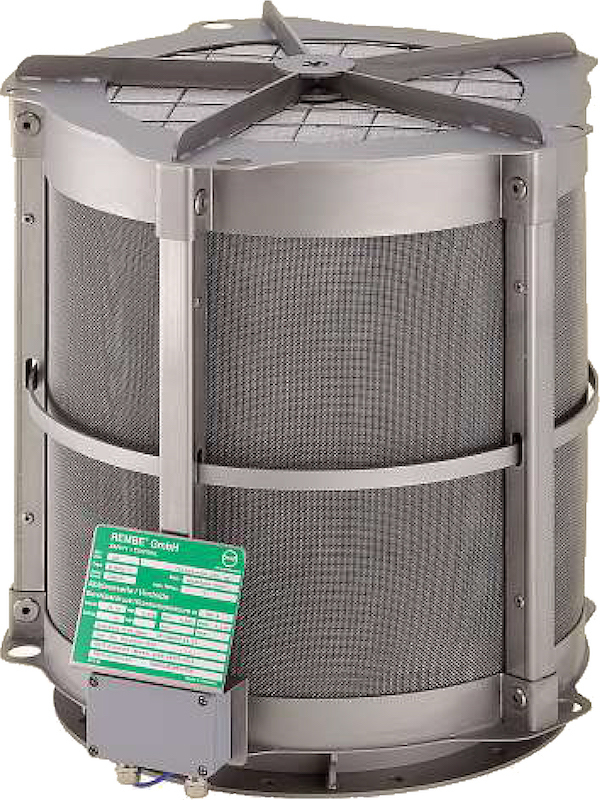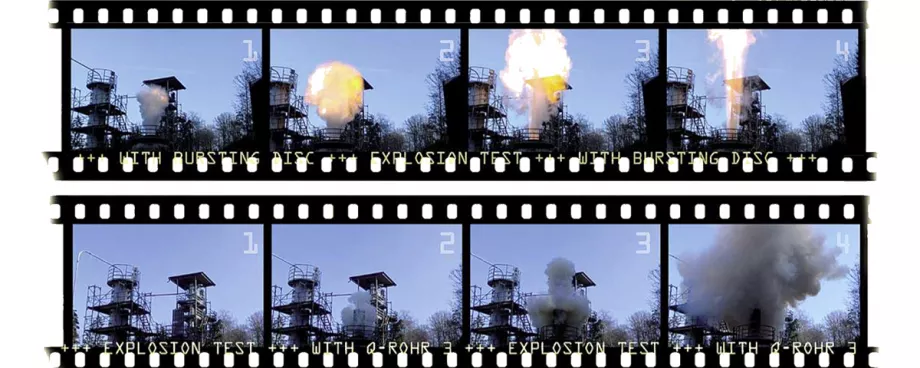(From the archive of ”bulk solids handling", article published in Vol. 32 (2012) No. 2 , ©2012 bulk-online.com)The new EN 16009:2011 "Flameless Explosion Venting Devices" has been in effect since October 2011. This norm establishes standardised requirements for all manufacturers in reference to construction and certification. EN 16009 applies to all autonomous flameless explosion venting protection systems. As the inventor of flameless explosion venting, the engineers at Rembe foresightedly designed the Q-Rohr (quenching mechanism with dust and flame retention for dust explosion venting) in a manner that fulfils all of the requirements of the EN 16009 in various inspection scenarios. The application area of this flameless venting device could even be extended to gases, hybrid mixtures and metal dust.

Rembe is the first manufacturer capable of providing the CE-Type Certification for the Q-Rohr-3, in accordance with EN 16009. The system is chiefly implemented for indoor flameless venting and during installation, cost-intensive venting ducts can be waived. Procedure-optimised installation within the immediate vicinity of people and machines is also an advantage, as is visual inspection without high-priced maintenance – a fact which has a significant effect on operating cost.
Functionality of the Q-Rohr

The flame gases reaching up to 1500°C (2732 °F. ) are extremely and efficiently cooled down through an energy transfer taking place in the special stainless steel mesh filter basket developed by Rembe. That leads to a reduction in discharging gas volumes and practically extinguishes the flame automatically. Additionally, the pressure rise and increased noise level associated with free vented explosions are massively reduced to negligible levels.The specially developed filter ensures that no burnt or unburnt dust particles are discharged. The Q-Rohr-3 indoor explosion venting is the world’s only flameless venting system that is licensed according to all currently relevant guidelines, e. g. NFPA 68, VDI 3673, EN 16009 or EN 14797. After replacing the bursting disc and simple cleaning, the system is immediately ready for further operation.
A Perfect Example
Spray-drying is an ideal area of application for the Q-Rohr-3. Spray-dryers are primarily deployed in the chemical and food industry, e. g. for the production of powdered milk. The liquids are sprayed in a drying tower by means of pressure nozzles or thrust washers. The powdery commodity is dried by hot current and countercurrent gas. This process is extremely explosive, as flammable dust is suspended in the air within the drying tower. If an ignition source is added, an explosion is inevitable. For this reason, necessity arises to install suitable protective measures within the facility.New basic interpretations, in accordance with the guideline VDI 2263 Data Sheet 7, have recently been released which address fire and explosion protection in spray-drying facilities (dust fires and dust explosions – hazards, evaluations and protective measures). The guideline takes into consideration that the temperature (leading to dust temperatures of 80 °C [176° F] within the drying tower) influences the maximum explosion pressure Pmax. In addition, under certain requirements only one third of the tower volume is needed for the calculation, as the product located in the upper area is still moist and thus, the atmosphere not explosive.
Less Relief Area
The Kst-Value is significantly influenced by the dust concentration. In this case, realistic dust concentration is used as the basis for a spray-dryer, with which the true concentration-dependent KEX-Value and thus, the required relief area is reduced. Thanks to this trend-setting calculation method, flameless explosion venting has become competitive in large plants as well. Active explosion venting systems that were previously deemed ideal for such applications are losing their supremacy.
Compared to Suppression
An explosion suppression system is comprised of a pressure detector, a control module as well as the extinguishing agent tanks. As soon as the detector senses an explosion, the extinguishing agent is blown in at high pressure and the explosion flame is actively extinguished. A suppression system must be regularly maintained. After an explosion, or potential false triggering, all extinguishing agent tanks must be replaced. Therefore, maintenance cost is very high.Suppression systems have advantages when handling toxic substances or active pharmaceutical ingredients, as no products are discharged into the environment during the suppression process. However, particular care must then be taken during cleaning and when recommissioning.The advantage is certainly accompanied by a negative aspect that should not be underestimated: the high annual maintenance costs share of approximately 10 to 15 per cent of the purchase price, as well as the cost and time effort for refilling after (false) triggering can quickly make the operating systems uneconomical. At least 70 per cent of the acquisition costs are assessed for resetting the system. And under certain circumstances, the entire product lot must be disposed of.
Outlook and Perspectives
Modern explosion protection systems must be safe and economically viable. This is the only way, by which the level of protection and thus, occupational safety, can be ensured. The EN 16009 as well as the VDI scientific series 2263, is strongly orientated to the operators' needs, as their initial objective is productivity and in turn, economic manufacturing processes that are accompanied by constructive explosion protection, and not hindered by it. Modern flameless venting equipment by Rembe meets these needs with absolute reliability.So this is what the future of constructive explosion protection actually looks like. Active systems will further uphold their significance on the market. On the other side, the passive systems are successfully coming up from the rear. This trend is also founded on the fact that passive systems, such as flameless venting, are easy to handle and that operators are not confronted with unsolvable tasks during inspection. However, this presumed simple technology will also call forward a number of black sheep as they attempt to hurl cheap copies onto the market.Rembe uses materials especially developed for this application, and only if correctly combined, do they offer maximum dust and flame retention. Such a complex flame retention system requires best engineering experience in designing and manufacturing to provide a safe performance. Copies of Rembe Q-Rohr System were found in the market looking similar but suffering from bad quality as well as poor engineering. These units endanger personnel and lead to major damages.Just recently, on a 26.5 cubic metre (935 838 cubic feet) sized test vessel, Rembe gave proof under notified body inspection during EC type examination tests that its Q-Rohr is also cut out for extreme explosion conditions. With a single device of 800 milliemtre internal diameter, dust explosions were flamelessly vented; in the past, this would have had to be vented by several devices. The secret is the Q-Rohr's patented design based on the aeronautical principle of stability and flexibility. The trick lies in riveted components capable of optimally absorbing the explosion’s shockwave. Imagine a rigidly welded aircraft wing: the slightest force would damage the wing and tear it off the body. Riveted wings vibrate, but effortlessly bear extreme forces as well.And the 3rd generation of the Rembe Flame-Trap is already in revision. The company sees many applications which can be served with the Q-Rohr in the near future, and that is the reason why Rembe keeps improving it, striving for even more universality.
A Note from the Editor
For all statements in this article that refer – directly or indirectly – to the time of publication (for example “new”, “now”, “present”, but also expressions such as “patent pending”), please keep in mind that this article was originally published in 2012.
| About the Authors | |
| Dipl.-Ing. Roland BunseHead of Explosion ProtectionRembe GmbH, Germany | |
| Dr.-Ing. Johannes LottermannChief Business Development Officer - Explosion SafetyRembe GmbH, Germany | |
| Stefan PennoManaging DirectorRembe GmbH, Germany |
■







